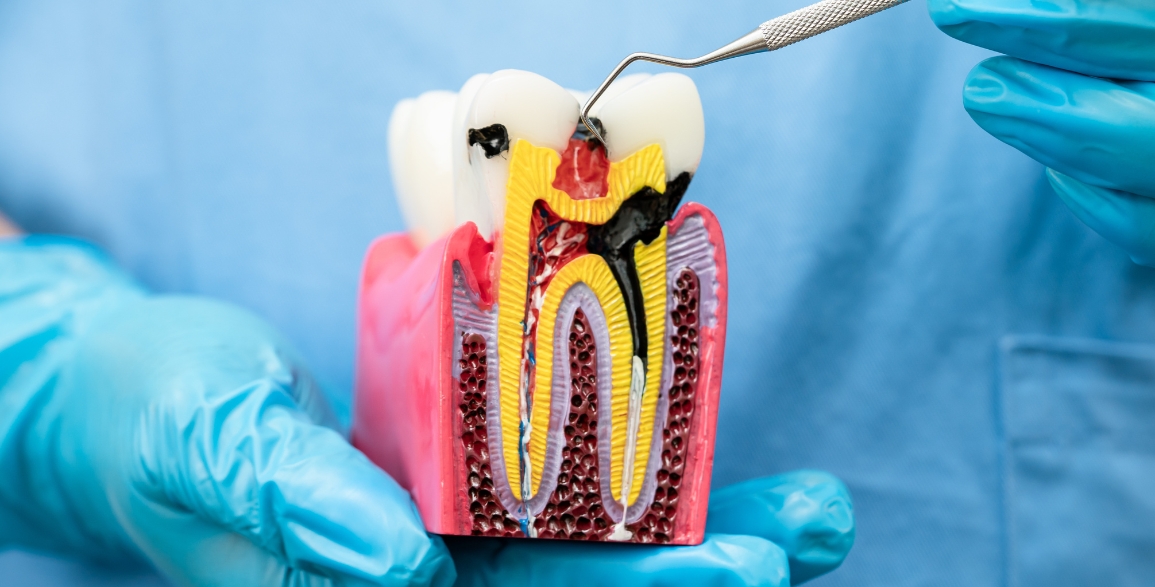Pay Online
How Can Root Canal Therapy Save Your Tooth from Extraction: A Bedford Guide

Preserving your natural teeth is essential for maintaining optimal oral health. However, many people have concerns about root canal therapy due to its intimidating reputation. In reality, root canal therapy is a highly effective treatment designed to save a tooth that would otherwise need to be extracted. This procedure removes infected tissue from within the tooth, allowing it to remain functional and intact. In this guide, we’ll walk you through how root canal therapy can save your tooth and why it might be the best option for your dental health.
What is Root Canal Therapy?
Root canal therapy (RCT) is a dental procedure used to treat an infection or inflammation inside the pulp of a tooth. The pulp is the soft tissue that contains nerves, blood vessels, and connective tissue. When this pulp becomes infected—usually due to deep cavities, cracks, or trauma—it can cause severe pain and lead to serious complications like abscesses.
Root canal therapy involves removing the infected pulp, cleaning the root canals, and sealing the tooth to prevent future infections. By doing this, the tooth can be saved from extraction, allowing it to continue functioning as a natural tooth.
Signs That You May Need a Root Canal
If you experience any of the following symptoms, you may need root canal therapy to save your tooth:
- Persistent tooth pain or sensitivity, especially when exposed to heat or cold.
- Swelling or tenderness in the gums around the affected tooth.
- Darkening of the tooth (a sign of infection or damage to the pulp).
- A pimple-like bump on the gums that may discharge pus.
- Pain while chewing or discomfort when touching the tooth.
These symptoms indicate that the pulp is compromised, and professional treatment is necessary to avoid further complications.
How Root Canal Therapy Saves Your Tooth?
Root canal therapy Bedford is designed to restore your tooth by removing infection and preventing further damage. The process generally involves the following steps:
- Step 1: Diagnosis and X-rays
The dentist will assess the damage with X-rays to determine the extent of the infection and confirm the need for a root canal. - Step 2: Removing the infected pulp
The dentist will create a small opening in the tooth to access the pulp and remove the infected tissue. - Step 3: Cleaning and shaping the root canals
The dentist cleans the canals and shapes them to remove any remaining bacteria or infected material. - Step 4: Filling the canals with a biocompatible material
Once cleaned, the canals are filled with gutta-percha, a rubber-like material that seals the tooth and prevents reinfection. - Step 5: Restoring the tooth with a crown
The final step involves placing a crown on the tooth to restore its strength and functionality. This also protects the tooth from further damage.
By following this procedure, root canal therapy preserves the tooth’s natural structure, preventing the need for extraction and helping to maintain the health of your surrounding teeth.
The Benefits of Root Canal Therapy Over Extraction
Root canal therapy offers numerous advantages when compared to extraction. Here’s why saving a tooth is often the best option:
- Better function: A natural tooth allows for proper chewing, speaking, and overall function, which a dental implant or bridge may not fully restore.
- Preserving jawbone health: Retaining your natural tooth helps maintain the integrity of your jawbone and prevents bone loss that can occur after extraction.
- Cost-effectiveness: Root canal therapy can save you from the high costs and time commitment associated with implants or bridges.
Myths About Root Canal Therapy
- Painful: Many people fear root canals because they associate them with pain. Modern anesthesia and techniques make the procedure relatively painless.
- Expensive: While the procedure may have a higher initial cost, it is more affordable than the long-term costs of tooth extraction and replacement.
- Ineffective: Root canal therapy has a high success rate, with most teeth remaining functional for many years after treatment. According to studies, root canal or endodontic treatments save around 15 million teeth each year.
When Extraction May Still Be Necessary?
While root canal therapy can save most teeth, there are times when extraction is the better option. Consider extraction if:
- Severe damage: The tooth is too damaged to save, even with a root canal.
- Multiple infections or fractures: If the tooth has recurring infections or fractures that cannot be treated effectively.
- Failed root canal therapy: If a previous root canal has failed and the tooth is still infected, extraction might be required.
A dental professional will carefully evaluate your condition to determine the best treatment plan for you.
Contact a Professional for Your Root Canal Therapy Needs
Root canal therapy is a highly effective procedure for saving teeth that would otherwise require extraction. If you’re experiencing symptoms of infection or need to learn more about your treatment options, consult with a dental professional to determine if root canal therapy is right for you.
Contact our office today to schedule an appointment or consultation and take the first step toward preserving your natural teeth and enhancing your oral health.

